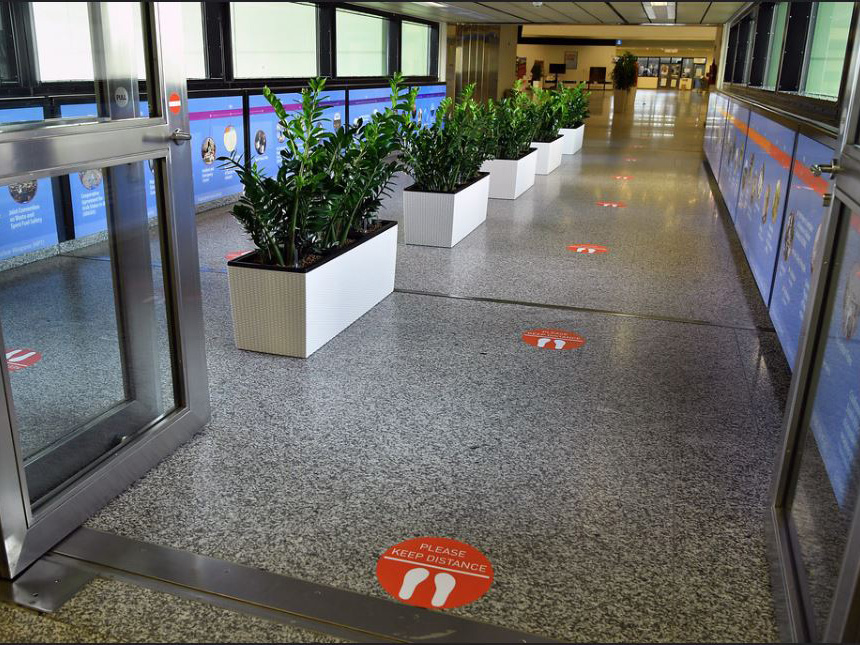Keeping Hospitality Alive During a Pandemic
Hotels and motels have been walloped harder than most property types by the COVID-19 pandemic. Still, there are signs that recovery might be underway.
Hotels and motels have been walloped harder than most property types by the COVID-19 pandemic. Still, there are signs that recovery might be underway.
National average hotel occupancy one year ago was around 64 percent, according to Brian Klein, a senior business strategist with travel and hospitality marketing company MMGY Global. According to an MMGY survey for the week ending June 8, occupancy was 39.3 percent, which would normally be rather horrible, but was in fact nearly double the low of 21 percent in early April, he explained.
READ ALSO: Can Mezzanine Loans Spur a Hospitality’s Rebound
Still, the hotel sector faces major obstacles, and is taking serious steps to deal with them.

Above, a floor sign reminds guests to socially distance. Hotel operators are preparing for the day when their lobbies will be crowded spaces once again. Photo courtesy of Dean Calma/IAEA
Keeping hospitality alive
Until a COVID-19 vaccine is developed, social distancing remains a core safety strategy. The key problem is that social distancing “is almost the antithesis of what historically hospitality has been about,” said Robert Mandelbaum, the director of research information services for CBRE Americas Hotel Research. “Hotels almost have to retrain their staff.”
Employees must adjust to procedural changes, which include an enhanced roll out of mobile check-in, and, on the food and beverage side, socially distanced front of house and back of house areas. Meanwhile, the previous trend to downsize food and beverage venues and push guests into the lobby will have to be reversed, though it’s hard to say for how long.
Lifestyle and boutique brands were already moving away from hands-on service, but full-service properties will have to make more modifications to their usual practices.
The pandemic’s effects are being seen everywhere on a hotel property, from the spa to the pool to the gym, where a guest might have to schedule a time to go in, Klein noted. And bellmen and valet parking attendants may become a thing of the past. In short, he said, high-touch customer service is turning into almost no-touch service.
Cleaner than ever
But while social distancing is highly visible, it’s “just one small piece of the puzzle,” Klein explained, and hygiene is the main factor. “The most important word in hospitality right now is clean.”
Every major hotel brand, he noted, has tightened its hygiene standards. For example, Hilton has partnered with the maker of Lysol, and will consult with the Mayo Clinic on the chain’s standards of cleanliness and disinfection. Similarly, InterContinental Hotels Group has teamed with the Cleveland Clinic, Ecolab and Diversey Inc. to add COVID-19 protocols to the company’s existing hygiene program.
During normal times, Klein said, “The housekeeping staff was meant to be hidden. There was nothing sexy about seeing a housekeeper vacuuming the lobby.”
Now, he says, a term one hears is “cleanliness theater,” analogous to the post-9/11 “security theater” of highly visible screenings at airports and other key locations. “Cleaning standards are now turning into a brand differentiator,” Klein said.
Will hotel guests see all these changes as impositions or amenities?
Klein cited a recent MMGY survey, which found that the majority of the frequent travelers who responded favored mandatory mask use by all hotel employees and in common areas by all hotel guests, limits on restaurant seating capacity, and the availability of disinfectant cleaner for guest use. Even temperature screenings at check-in and public areas were supported by sizable minorities of those responding—42 percent and 34 percent, respectively.
It’s “a new normal,” said Klein.
Sector Insights rotates among office/medical office, industrial, retail, multifamily, self storage and hotel/hospitality.
You’ll find more on this topic in the CPE-MHN 2020 Midyear Update.








You must be logged in to post a comment.